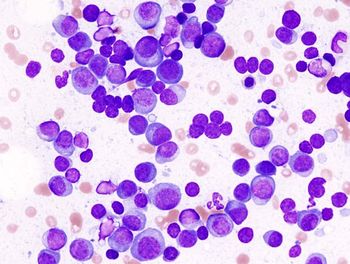
- ONCOLOGY Vol 21 No 1
- Volume 21
- Issue 1
Targeted Focal Therapy in Prostate Cancer: Too Soon for a Paradigm Shift
The morbidities associated with prostate cancer treatments have improved over the years. However, potential overtreatment and the risks of adverse events associated with radical treatment still pose a considerable challenge. Targeted focal therapy (TFT) of prostate cancer appears to be part of a logical continuum in the quest to improve upon the management of early organ-confined disease. TFT is a procedure in which only the cancer in the gland is ablated. The normal gland, sphincter, and in most cases the neurovascular bundles are preserved. Therefore, this approach averts some of the common complications of more radical therapy. Initial experience has been encouraging; however, long-term data and full implementation of emerging advances in imaging are urgently needed before the widespread adoption of this approach. In this review, we present the current status of our knowledge about this procedure and the most important challenges that need to be addressed. We also present the initial results with this approach at our center.
Cryosurgical ablation of the prostate was conceived in 1988, with the first case being performed in 1990. The population of men presenting with disease was markedly different compared to today. The typical patient that cryosurgery was designed to treat had stage B2/C disease with moderately to poorly differentiated pathology. He usually had some evidence of voiding dysfunction, and only two to four cores of the prostate were sampled with a Tru-Cut needle. Presently, the patient has stage cT1c disease, a prostate-specific antigen (PSA) level less than 10 ng/mL, is younger, and considers the option of preserving erectile dysfunction a reasonable requirement of treatment. Clearly, these are two different populations.
Similarly, the biology of this disease remains an enigma. Autopsy studies clearly document a prevalence of disease that exceeds the steady-state diagnosis of prostate cancer on a yearly basis. Sakr et al demonstrated that 28% of men between 40 and 49 years old had a focus of disease.[1] The prevalence increased as age advanced. If the diagnosis rate is 200,000 cases per year, then the number of men between 40 and 75 who have the disease is greater than 10,000,000. The population of men who have the disease far outstrips this number, indicating that there are a large number of men with the disease who will not be impacted. Are the treatment successes seen in men who would have not been negatively affected by this disease?
Additional Questions
Further problems exist as to whom to treat. Is it the patient with a large volume of disease or is it the patient who has an unfavorable Gleason scorepattern 4 or 5? Is it a combination of the volume and the pathology that should guide treatment? Is the origin of metastatic disease the central or peripheral zone? Clearly, there are more questions then definitive answers on which to base a treatment decision for the individual patient.
Finally, where is the malignancy located? As Crawford and Barqawi point out, there is no reliable imaging technique for prostate cancer. If there were, then focal ablation would be the standard of care as it is in many other tumor systems. Currently, there is nothing to suggest that focal ablation guided by pretreatment biopsy plans is effective in achieving the stated goals of treatment efficacy and long-term survival. It needs further investigation.
Conclusions
If the goal of treatment is to preserve potency and continence, then in early-stage disease the best treatment option is expectant management. The stated "overwhelming interest" expressed by patients suggests that the standard treatment options are not meeting their expectations. If they were, then the public would perceive equivalence of treatments and there would be no need to look any further. Either the profession is not getting the message out regarding the lack of treatment complications or the patients are sending one back-disbelief.
Targeted focal therapy (TFT), as described by Crawford and Barqawi, involves a well-selected patient population that is at low risk. The patients who undergo this form of treatment should be entered into an IRB-approved protocol with clearly defined outcome measures to judge efficacy in disease control and quality of life. As with any form of therapy, there remains the occasional patient who should be treated in this fashion. Any significant paradigm shift in treatment should be reviewed and scrutinized by standard means. When we are blinded to the location and severity of the disease, the change in treatment philosophy cannot be justified by patients attempting to preserve what may be unpreservable.
Jeffrey K. Cohen, md
Disclosures:
Dr. Cohen is a consultant for Oncura.
References:
1. Sakr WA, Haas GP, Cassin BF, et al: The frequency of carcinoma and intraepithelial neoplasia of the prostate in young male patients. J Urol 150:379-385, 1993.
Articles in this issue
almost 19 years ago
'Repairing the World'almost 19 years ago
Evolving Classification and Management of Myelodysplastic Syndromealmost 19 years ago
Tailoring Endocrine Therapy in Breast Cancer Patientsalmost 19 years ago
The Significance of Anemia in Elderly Patients with Canceralmost 19 years ago
Optimizing Endocrine Therapy for Breast Cancer: 'Miles to Go'almost 19 years ago
Landmark Lapatinib Data Publishedalmost 19 years ago
Practice Guidelines Released for HER2 Testing in Breast Canceralmost 19 years ago
Age Matters... Or Does It?almost 19 years ago
New Vaccine Helps Fight Colorectal Cancer in British Studyalmost 19 years ago
New Therapeutics for Soft-Tissue Sarcomas in AdultsNewsletter
Stay up to date on recent advances in the multidisciplinary approach to cancer.

















































































